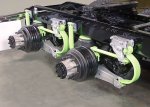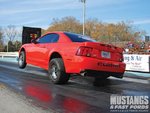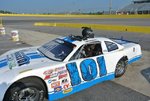Norm Peterson
Corner Barstool Sitter
I'll have to grab a few pictures of the rear suspensions on the trucks my son and son-in-law drive for a better view of anything I can find online, but it looks like one Class 8 arrangement is a sort of upside-down torque arm type (the control arm picks up above the axle and the "torque arm" itself is a link-style that attaches below the axle, the link being that curved component). That would put the SVIC above axle height close to the control arm's chassis side pickup forcing the antisquat construction line slope to be somewhere in excess of 45°.If you're talking about the 5th wheel rising while pulling a trailer, I think that's just the reaction from the high CG load it's pulling.
Watch a semi's tractor running bobtail sometime.

Norm
















